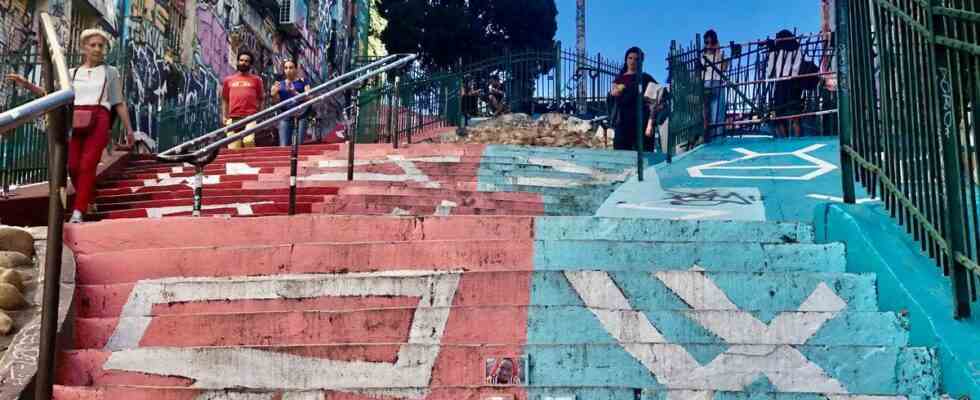The Marseillais will not say the opposite. “Marseille is the most beautiful city in the world. There aren’t two like that in the world,” sang Massilia Sound System, one of Marseille’s iconic groups of the 1990s/2000s who made their debut on the Cour Ju. after magazine Time which this summer ranked the city as “one of the fifty most beautiful places in the world”, its cousin the TimeOut elected one of its neighborhoods, the Cour Ju, as “the tenth coolest neighborhood in the world”. Just that. And the icing on the cake, it is far ahead of the second classified French district, that of the Marais, in Paris, positioned 44th.
This district of the city center, a gateway between La Plaine and Noailles and served by a metro stop (which is rare enough to be highlighted here), offers “a nice cultural offer” in which Julien finds himself. This forty-something civil servant, who has lived in the neighborhood for 20 years, reads Hiding in the madhouse on the terrace of a café shaded by the many lime trees, cypresses and olive trees in the square (other rare foodstuffs in Marseille to be underlined). Between record stores and publishing houses, the many concert halls of all sizes testify to this cultural dynamic: from the confidential Dar lamifa, down rue d’Aubagne, passing by Le Molotov, one of the locomotives of the district, to Espace Julien, one of the “big” institutional venues in the city. A definitely “creative” district, as evidenced by the street art frescoes covering the walls of shops and alleys, largely pedestrianized (another rarity in Marseille) rising towards the Plain, another key place for Marseille nights. In short, “a colorful and lively atmosphere”, summarizes Patricia, who responded to our call for testimonials sent out previously.
Only authentic shops
“A creative hotbed covered with small shops, concert halls, vintage thrift stores, second-hand books and old warehouses converted into art galleries”, had described the author of TimeOut which leaves other Marseillais more circumspect. “If Americans classify it as cool, it’s because they can go sightseeing there,” tackles Ludo, a bicycle repairman. “Parisians say it looks like their 10th arrondissement, but I don’t know, I’ve never been there,” adds Seb, his fellow comic book author with whom he shares the lunch break. “And what does that really mean cool? Cool for whom? “, philosopher Julien. “There is a mix of people here that I really like. It is perhaps becoming less and less obvious because this district attracts. A great neighborhood is always on the go. Either it becomes impoverished, or it becomes gentrified and sanitized,” he continues.
For the time being, the district remains largely multicultural where a Brazilian restaurant can rub shoulders with an Indian, a Tunisian or a post-industrial style optical shop with seats made from scooter seats. Here, there are no chains, only authentic shops, from the hairdresser baptized “Left Bank” to the clothing boutiques. A place that Sofiane* and Youssef*, two social mediators for an association assigned to this sector for a week are discovering. Pure Marseillais, they had never been so far from their city in the 15th arrondissement, located north of the city. “It’s tagged everywhere, I think that’s what people like. Finally I find it super nice, it’s friendly, there are plenty of restaurants, ”comments one. “If tomorrow I am offered accommodation here, I will take it straight away,” adds his colleague. “It’s quiet here, and you know that when you see these beautiful bikes strapped right to the frame. You do that in Joliette, you come back, you have one wheel left. There are even buried garbage containers, it’s not everywhere that”, they admire, before qualifying: “Finally there are still black spots. »
“Everyone wants to find the new Berlin”
Black points that many Internet users wanted to mention. “Cour Ju is just Estienne-d’Orves with more grafs and cassos,” laughs Michael. “A real soul emanates from this square, between street art, freedom of expression and activism, it’s a very nice place. But when the bars close after an hour or two, the neighborhood can become dangerous,” notes Thomas. Attendance at late hours of the night regularly pointed out as problematic, in addition to dirt, in the testimonies received.
“The Cour Ju is unique”, defines a young American-Italian who grew up in Paris, “musician and poet” stranded here, where his sister settled, after a few years of travel. “Everyone wants to find the new Berlin,” he says. And as such, it would seem that Marseille is holding the line these days, as the city currently attracts young creative people from all walks of life.
But like all places judged to be “cool”, they cease, in a sense, to be so as soon as they are identified, victims of their attraction which is too quick to transform them, to “museify” them. In Europe the examples are legion. From Christiana in Denmark, to Camden in London, via the Kreuzberg in Berlin. And if the Cour Ju knew the same fate, it would already, perhaps, be a success.
*Their first names have been changed vis-à-vis their employer.

